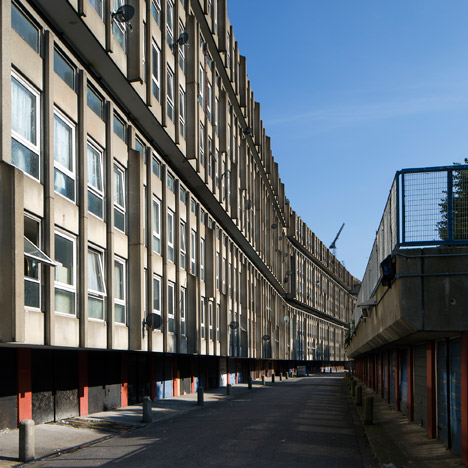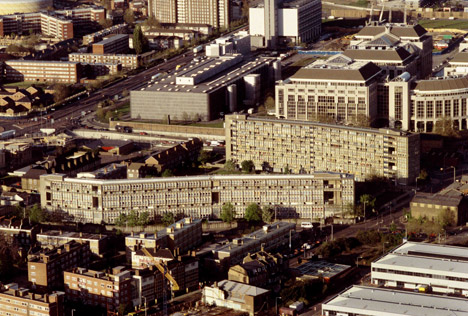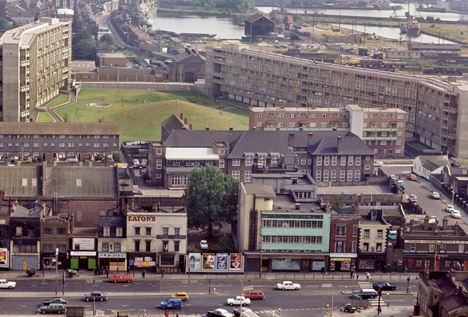Richard Rogers calls for architects to help save "exceptional" Robin Hood Gardens
Architect Richard Rogers has urged the architectural community to support the preservation of the Brutalist Robin Hood Gardens estate, which he has described as post-war Britain's most important social housing development.
Rogers and colleague Simon Smithson – the son of Robin Hood Gardens' architects Alison and Peter Smithson – have sent an open letter to members of the architecture, design and construction communities calling for them to join the campaign to save the ill-fated estate, which is scheduled for demolition to make way for a new housing development.
"In my opinion, it is the most important social housing development from the post-war era in Britain," said Rogers in the text.

The letter follows the revival of a high-profile campaign to save the estate, which was backed by hundreds of architects, including Zaha Hadid, Robert Venturi and Toyo Ito.
The UK government granted a five-year immunity from heritage listing in 2009, meaning that local council Tower Hamlets was able to approve demolition, but that period has expired. Heritage organisation the Twentieth Century Society has since submitted a new report claiming the decision not to protect the estate the first time around was misguided.
Rogers and Smithson are now asking friends and colleagues to support this paper by appealing to UK culture minister Tracey Crouch to review the decision made by her predecessor, Andy Burnham.

"The buildings, which offer generously sized flats that could be refurbished, are of outstanding architectural quality and significant historic interest, and public appreciation and understanding of the value of Modernist architecture has grown over the past five years, making the case for listing stronger than ever," they said.
"Last time listing was considered the views of the architectural community were ignored but we believe there is now a real chance of saving the building for posterity but only if the minister hears, first hand, the views of the profession on the architectural merits of these exceptional buildings."
A statement from Delft University professor Dirk van den Heuvel – a post-war architecture expert and a leading authority on Alison and Peter Smithson – is also included in the letter.
He said: "Despite the current state of neglect and abuse, Robin Hood Gardens comprises a rare, majestic gesture, both radical and generous in its aspiration for an architecture of human association. As such it still sets an example for architects around the world."

Located in Poplar, east London, Robin Hood Gardens was completed in 1972 by the Smithsons, based on the concept of "streets in the sky". The estate contains 213 apartments within two concrete slab blocks, arranged either side of a garden of grass mounds.
Its demolition is planned as part of a housing project led by development company Swan and supported by Tower Hamlets council.
See the letter in full below:
Dear Friends,
I am writing to ask you to support listing Robin Hood Gardens as a building of special architectural interest, in order to protect one of Britain's most important post-war housing projects, designed by Alison and Peter Smithson, from demolition.
Previous efforts in 2009 to have the building listed failed, but the case has now been re-opened and we understand that the new Minister for Sport, Tourism and Heritage will be reviewing the arguments at the end of this week. The buildings, which offer generously-sized flats that could be refurbished, are of outstanding architectural quality and significant historic interest, and public appreciation and understanding of the value of modernist architecture has grown over the past five years, making the case for listing stronger than ever.
The UK's 20th Century Society has submitted a paper setting out why they believe Robin Hood Gardens should be listed (i.e. added it to the statutory list of buildings of special architectural and historical interest). Two further assessments are set out below:
"Alison and Peter Smithson were the inventors of the New Brutalism in the 1950s and as such they were the 'bellwethers of the young' as Reyner Banham called them. In many ways [Robin Hood Gardens] epitomises the Smithsons' ideas of housing and city building. Two sculptural slabs of affordable housing create the calm and stress free place amidst the ongoing modernisation of the London cityscape. The facades of precast concrete elements act as screens that negotiate between the private sphere of the individual flats and the collective space of the inner garden and beyond. The rhythmic composition of vertical fins and horizontal 'streets-in-the-air' articulates the Smithsons' unique proposition of an architectural language that combines social values with modern technology and material expression. Despite the current state of neglect and abuse Robin Hood Gardens comprises a rare, majestic gesture, both radical and generous in its aspiration for an architecture of human association. As such it still sets an example for architects around the world." – Dr Dirk van den Heuvel, Delft University, Holland.
"The Smithsons were clearly great architects: the Economist Building, completed in 1964 and Grade I-listed in 1988, is without a doubt the best modern building in the historic centre of London. Robin Hood Gardens, which pioneered 'streets in the air' to preserve the public life of the East End terraces that it replaced, was the next large-scale job that the Smithsons embarked upon. It was architecturally and intellectually innovative. In my opinion, it is the most important social housing development from the post-war era in Britain." – Lord Richard Rogers
Last time listing was considered the views of the architectural community were ignored but we believe there is now a real chance of saving the building for posterity but only if the Minister hears, first hand, the views of the profession on the architectural merits of these exceptional buildings.
Can we ask you to support the efforts of the 20th Century Society by writing right now to the Minster to support listing and saying why you believe Robin Hood Gardens should be saved?
Also, can we ask you to forward this e-mail to anyone else you know who might be willing to help save these important buildings?
Yours sincerely,
Richard Rogers and Simon Smithson